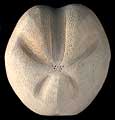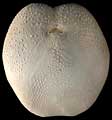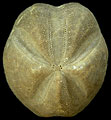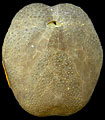|
Diagnostic Features
|
-
Test ovate with distinct anterior sulcus; posterior face truncate.
-
Apical disc hemiethmolytic or ethmolytic with four gonopores; wider than long with anterior and posterior gonopores on either side close together; central.
-
Ambulacrum III sunken from apex to peristome (deepest aborally). Pore-pairs differentiated with prominent interporal ridge, presumably associated with funnel-building tube-feet.
-
Paired ambulacra petaloid; petals sunken and bowed; closed distally. Posterior petals generally about half to two-thirds length of anterior petals.
-
Peristome pentagonal and tilted slightly towards anterior.
-
Labral plate longer than wide, extending to third ambulacral plate. Sternal plates large, symmetrical and forming most of oral surface. Episternal plates offset.
-
Periproct small, situated towards top of posterior truncate face.
-
Enlarged subanal pore-pairs present.
-
Peripetalous fasciole present; indented by one plate behind anterior petals. No other fascioles.
|
|
Distribution
|
Upper Cretaceous (Upper Cenomanian to Maastrichtian), Europe, former SSU, Africa, North and South America.
|
| Name gender |
masculine |
| Type |
Hemiaster fourneli Agassiz & Desor 1847, p. 16, by original designation.
|
| Species Included |
-
M. fourneli Deshayes, in Agassiz & Desor, 1847; Turonian to Maastrichtian, Brazil, North and West Africa.
-
M. africanus (Coquand, 1862); Turonian, Algeria and Brazil.
-
M. longus Cotteau & Gauthier, 1895; Senonian, Iran.
-
M. mutabilis (Lambert, 1933); Turonian, Madacascar and India
-
M. obliquetruncatus Peron & Gauthier, 1880; Turonian, Algeria.
-
M. texanus (Roemer, 1849); Santonian-Campanian, North and central America.
-
M. batnensis (Coquand, 1862); Cenomanian-Turonian, Brazil, North Africa, Texas.
-
M. scutigera (Forbes, 1850); Cenomanian, Portugal.
-
M. victoris (Lambert, 1932); Campanian-Maastrichtian, Algeria, Oman, Turkey.
-
M. cubicus Desor, in Agassiz & Desor; Cenomanian, Middle East.
-
M. arnonensis Neumann, 1999; Santonian, Jordan.
-
many other nominal species of questionable validity have been established (see Neraudeau 1994 for comprehensive list and Smith & Bengtson 1991 for discussion of genus).
|
| Classification and/or Status |
Spatangoida, Hemiasterina, Hemiasteridae.
Paraphyletic?
|
| Remarks |
Differs from Hemiaster in having an ethmolytic (or hemiethmolytic) apical disc. It also has much longer and better developed petals than Hemiaster. Closest to Jordaniaster but differs in having a shorter labrum, more symmetrical sternal plates and an ethmolytic rather than ethmophract apical disc.
Smith, A. B. & Bengtson, P. 1991. Cretaceous echinoids from north-eastern Brazil. Fossils and Strata 31, 1-88.
Neraudeau, D. 1994. Hemiasterid echinoids (Echinodermata: Spatangoida) from the Cretaceous Tethys to the present-day Mediterranean. Palaeogeography, Palaeoclimatology, Palaeoecology 110, 319-344.
|








